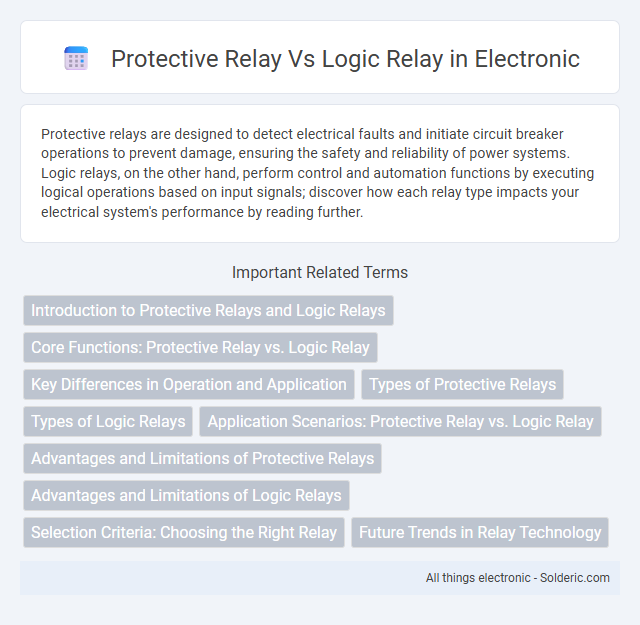Protective relays are designed to detect electrical faults and initiate circuit breaker operations to prevent damage, ensuring the safety and reliability of power systems. Logic relays, on the other hand, perform control and automation functions by executing logical operations based on input signals; discover how each relay type impacts your electrical system's performance by reading further.
Comparison Table
| Feature | Protective Relay | Logic Relay |
|---|---|---|
| Purpose | Detects electrical faults and protects equipment | Executes logical control operations based on input conditions |
| Function | Fault detection, isolation, and system protection | Implements Boolean logic for control circuits |
| Types | Electromagnetic, static, microprocessor-based | Electromechanical, solid-state, programmable |
| Input Signals | Current, voltage, frequency, power | Binary signals from contacts or sensors |
| Application | Power system protection and fault clearing | Logic control in automation and switching |
| Response Time | Fast, typically milliseconds | Moderate, depending on logic complexity |
| Output | Trip signals to circuit breakers or alarms | Control outputs for relays or devices |
| Complexity | High due to protection algorithms | Relatively simple, logic-based |
Introduction to Protective Relays and Logic Relays
Protective relays are specialized devices designed to detect electrical faults and initiate circuit breaker operation to protect power systems from damage. Logic relays, on the other hand, perform logic operations such as AND, OR, and NOT to control circuits based on input signals without fault detection functions. Understanding the distinction between protective and logic relays enables you to select the appropriate device for fault protection or control logic applications in electrical systems.
Core Functions: Protective Relay vs. Logic Relay
Protective relays primarily perform fault detection and isolation by monitoring electrical parameters such as current, voltage, and frequency to safeguard power systems from damage. Logic relays execute predetermined control sequences and interlock operations using Boolean logic to manage system automation and equipment coordination. While protective relays focus on safety and system stability, logic relays emphasize control logic and operational order within electrical networks.
Key Differences in Operation and Application
Protective relays are designed to detect faults and abnormalities in electrical systems, instantly triggering circuit breakers to prevent equipment damage and ensure safety, whereas logic relays perform pre-programmed control functions within industrial automation by processing input conditions and executing logic operations. Protective relays prioritize real-time fault detection with high-speed response and sensitivity, making them essential for power system protection, while logic relays focus on sequential control tasks and flexibility in process management. Your choice between these relays depends on whether the application requires rapid fault isolation or complex control logic execution in electrical or industrial environments.
Types of Protective Relays
Protective relays include types such as electromechanical, solid-state, and numerical relays, each designed to detect electrical faults and ensure system safety. Electromechanical relays operate mechanically with moving parts, solid-state relays use electronic components for faster response, and numerical relays employ microprocessors for advanced protection and monitoring functions. Logic relays, by contrast, are primarily designed for control logic operations rather than fault detection.
Types of Logic Relays
Logic relays include types such as AND, OR, XOR, and NOT relays, each designed to perform specific logical operations essential for controlling electrical circuits. Unlike protective relays, which primarily safeguard equipment by detecting faults like overcurrent or undervoltage, logic relays enable complex automation sequences by processing multiple inputs to produce precise control outputs. Your choice between protective and logic relays depends on whether the priority is fault protection or intricate control logic execution.
Application Scenarios: Protective Relay vs. Logic Relay
Protective relays are primarily used in power systems for fault detection, isolation, and equipment protection, ensuring system stability and safety in scenarios like circuit breaker tripping during overloads or short circuits. Logic relays are employed in automation and control systems to execute predefined logical operations, commonly used for sequence control, interlocking, and process automation in industrial applications. While protective relays focus on detecting and responding to electrical anomalies, logic relays are designed to manage control logic and machine operations based on input signals.
Advantages and Limitations of Protective Relays
Protective relays offer precise fault detection and rapid response times, enhancing equipment safety and minimizing power outages in electrical systems. Their limitations include higher complexity and cost compared to logic relays, and the need for regular maintenance to ensure optimal performance. Your choice of protective relays should balance these advantages with operational requirements and budget constraints to achieve reliable power system protection.
Advantages and Limitations of Logic Relays
Logic relays offer advantages such as flexible programmability, compact design, and ease of integration into control circuits, making them ideal for complex automation tasks. However, their limitations include sensitivity to electrical noise, reliance on power supply stability, and potential programming errors, which can affect reliability compared to traditional protective relays. You should evaluate these factors carefully when choosing between protective and logic relays for safety-critical applications.
Selection Criteria: Choosing the Right Relay
Selecting the right relay involves evaluating key criteria such as application requirements, response time, and operating conditions. Protective relays are ideal for fault detection and system protection in power networks, emphasizing high sensitivity and selectivity, while logic relays excel in control circuits where complex logical functions and programmable operations are needed. Consider factors like voltage ratings, environmental conditions, and integration capabilities to ensure optimal performance and reliability in industrial or utility settings.
Future Trends in Relay Technology
Protective relays are increasingly integrating advanced digital and IoT capabilities to enhance fault detection accuracy and system reliability in smart grids. Logic relays are evolving with programmable, networked architectures that allow dynamic control and real-time automation in complex industrial processes. Both relay types are moving towards AI-driven diagnostics and edge computing to improve predictive maintenance and operational efficiency.
Protective relay vs logic relay Infographic

 solderic.com
solderic.com